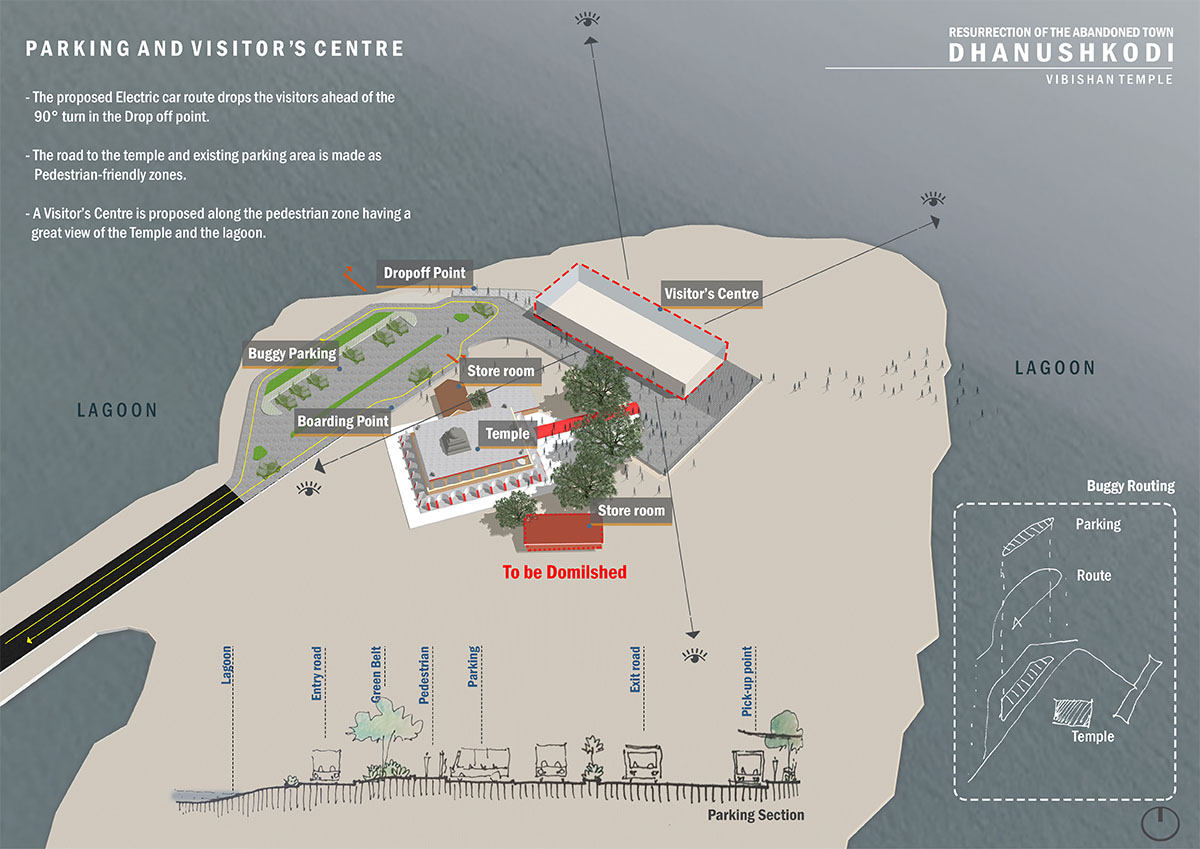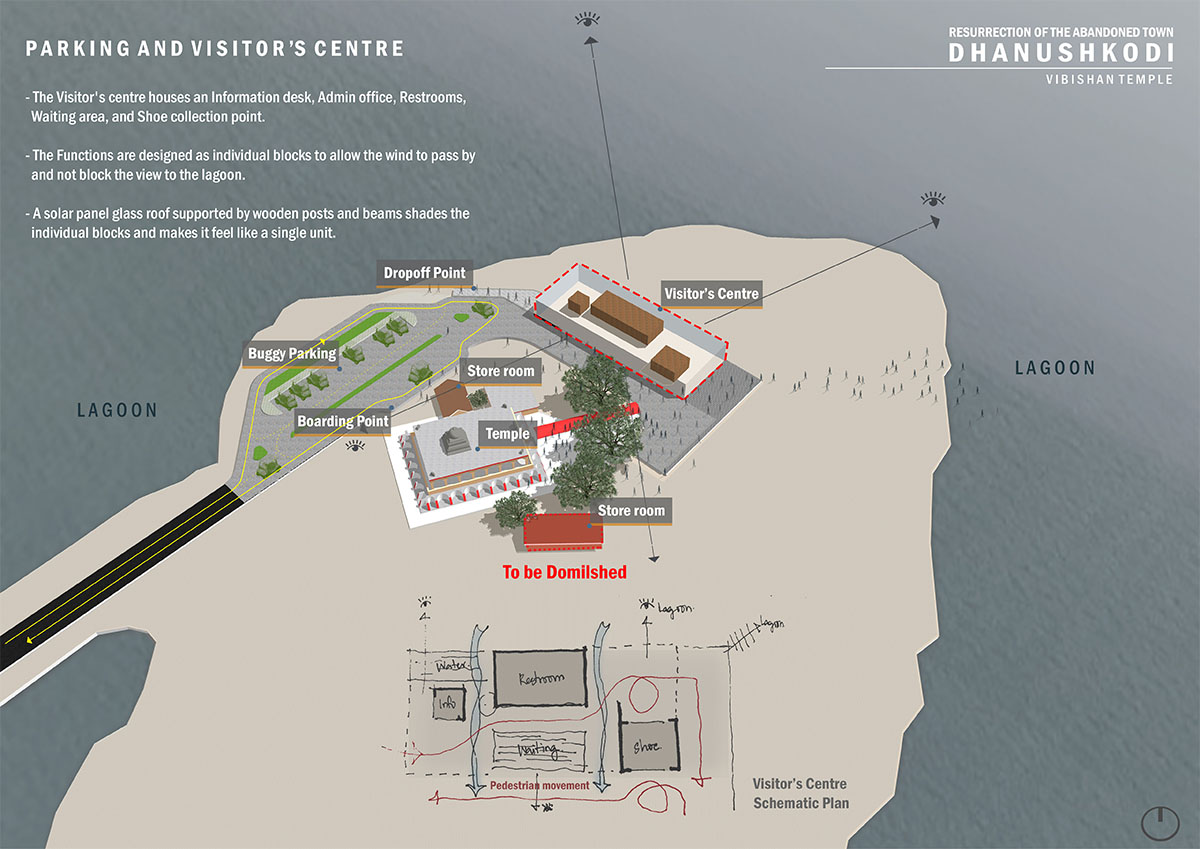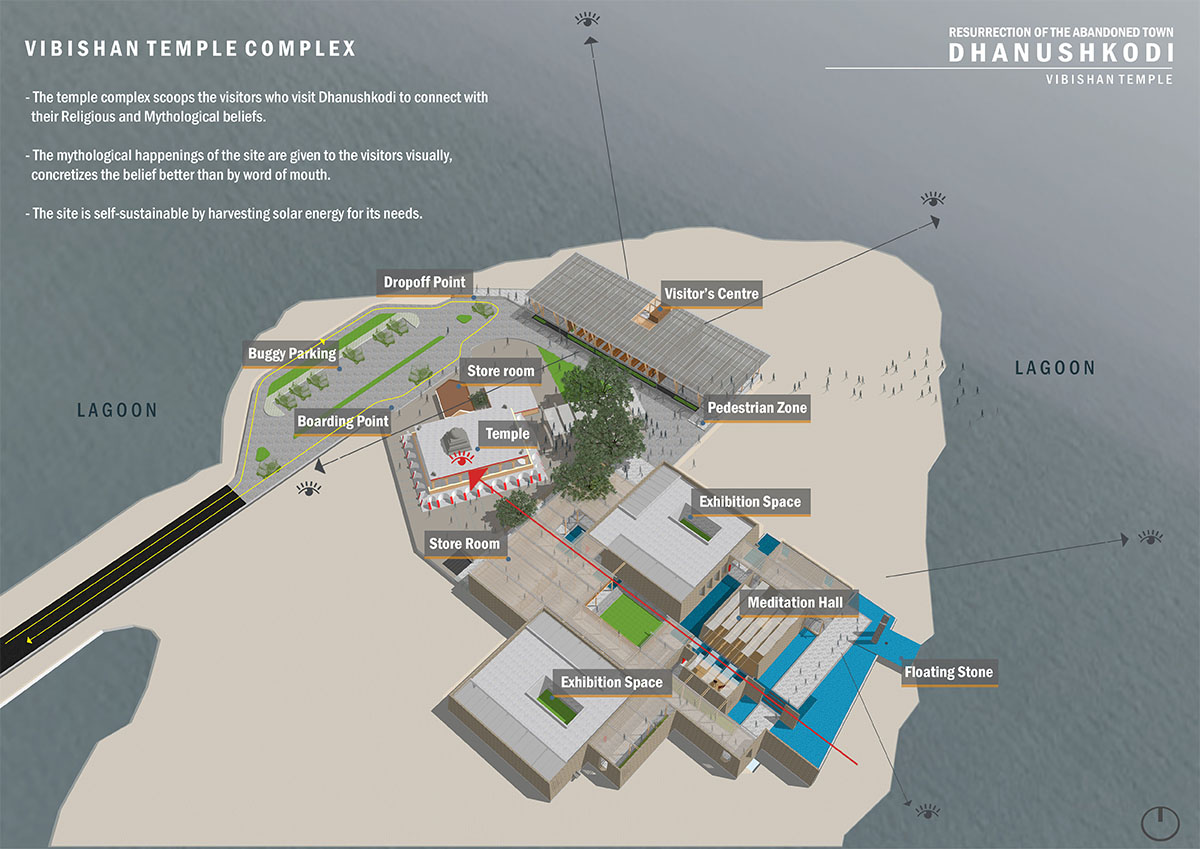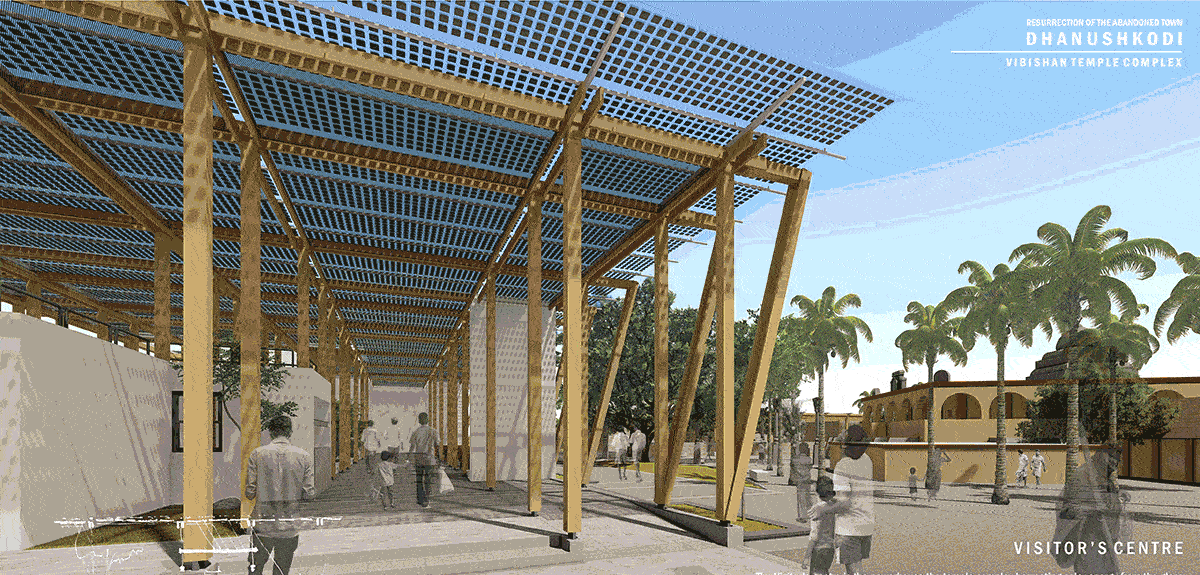
Vibishan Temple Complex
Vibishan temple is located 3 km from the Entrance complex. It is said that the temple hosted the Coronation ceremony of Lord Vibishana brother of Lord Ravana. This Temple is recognised as a Pilgrimage and Heritage site by the Indian Ministry of Tourism. The Temple sits on a small islet in the middle of the Lagoon connected by a causeway road. The lagoon holds water for 4 months in a year (December to March). The site profile is a direct result of wind direction and wave shift erosion/accretion. The site is surrounded by water and has great views of the Lagoon. These aspects of the site environment can be utilized to benefit the design intervention.
Religious Connect | Information Center | Spiritual Plaza
Thesis Project | Ar.R.M.Valliappan
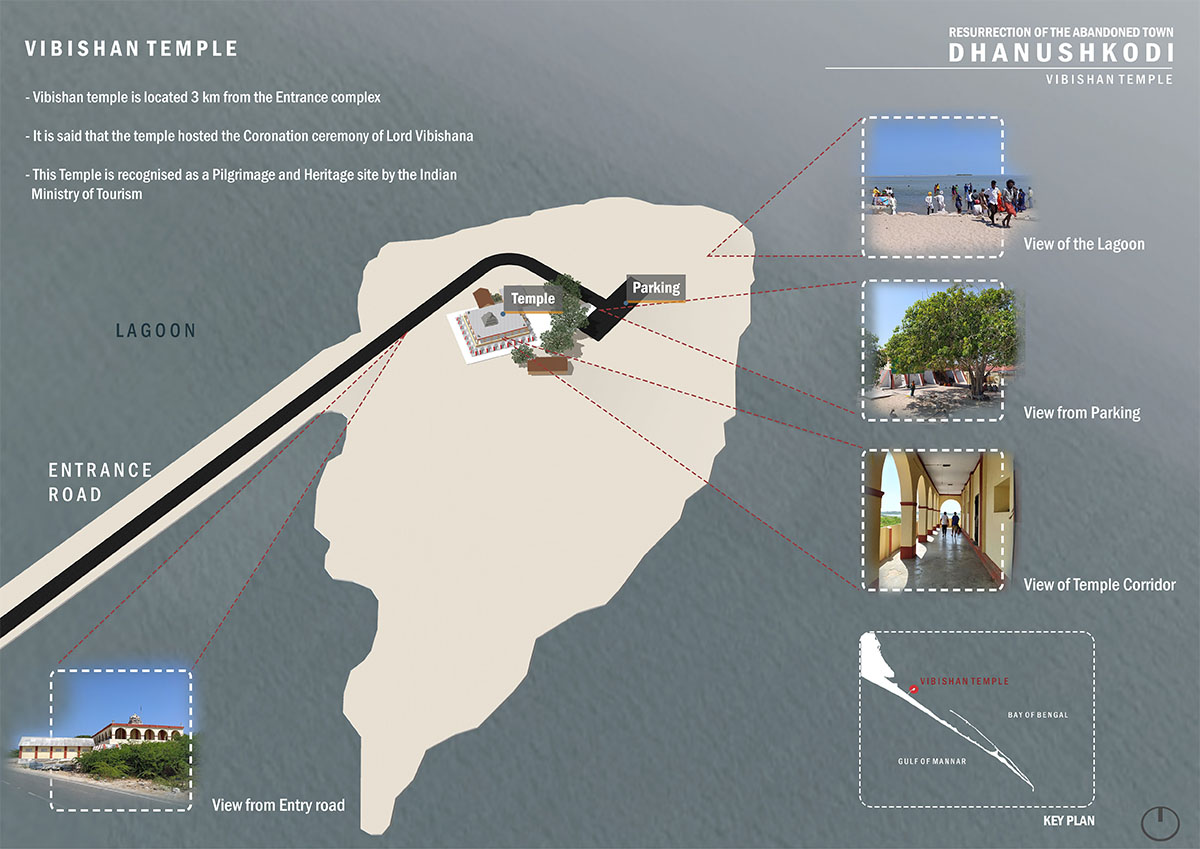
Vehicles experience difficulty with visibility in the sharp 90° tum. Conflict of Pedestrian and vehicular movement in the temple entrance and parking area. The Parking facility is insufficient for the number of Pilgrims and visitors.

The proposed Electric car route drops the visitors ahead of the 90 turn in the Drop off point. The road to the temple and existing parking area is made as Pedestrian-friendly zones. A Visitor's Centre is proposed along the pedestrian zone having a great view of the Temple and the lagoon.
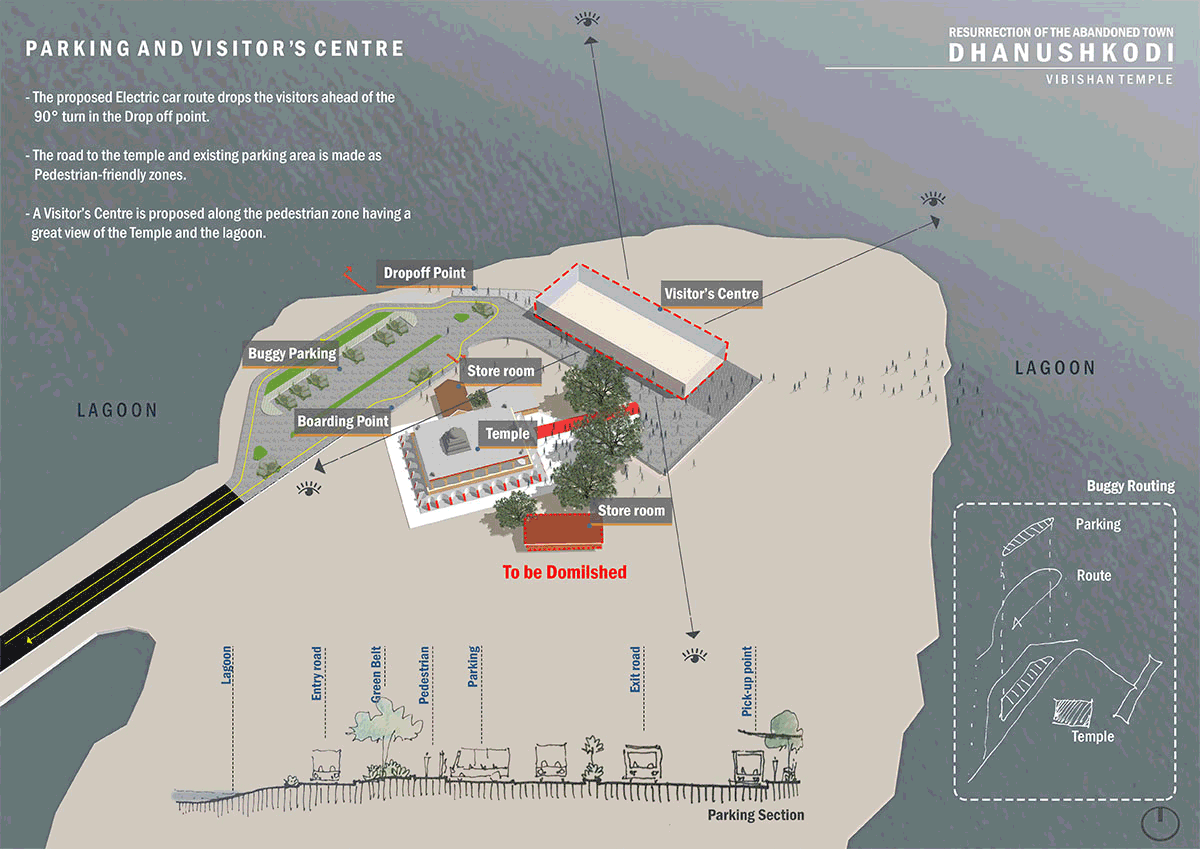
The Visitor's centre houses an Information desk, Admin office, Restrooms, Waiting area, and Shoe collection point.The Functions are designed as individual blocks to allow the wind to pass by and not block the view to the lagoon. A solar panel glass roof supported by wooden posts and beams shades the Individual blocks and makes it feel like a single unit. Vistors are taken in a clockwise movement around the complex, The Interpretation centre depicts the Sundara Kanda and Yudha kanda of Ramayana that are believed to have taken place in Dhanushkodi. The Interpretation centre houses Two exhibition Spaces, Meditation Hall, Visual connect to Ram Sethu bridge and a Store room
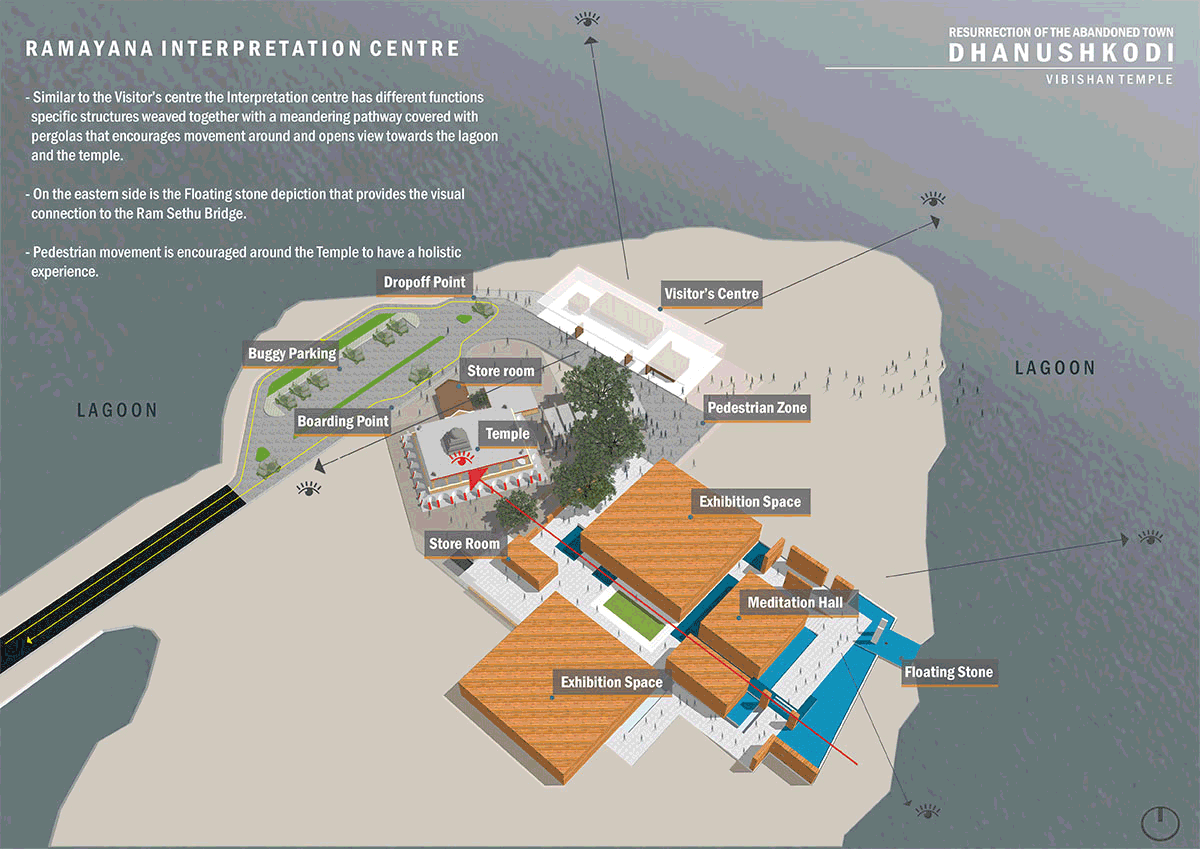
Similar to the Visitor's centre the Interpretation centre has different functions specific structures weaved together with a meandering pathway covered with pergolas that encourages movement around and opens view towards the lagoon and the temple.On the eastern side is the Floating stone depiction that provides the visual connection to the Ram Sethu Bridge. Pedestrian movement is encouraged around the Temple to have a holistic experience.
The temple complex scoops the visitors who visit Dhanushkodi to connect with their Religious and Mythological beliefs. The mythological happenings of the site are given to the visitors visually, concretizes the belief better than by word of mouth. The site is self-sustainable by harvesting solar energy for its needs. Exhibition modules are designed in relevance with the site surroundings and conditions, Openings are provided along the walls that run along the strong wind direction so they don't invite harsh environmental conditions indoors. A water channel runs all along the Interpretation centre connecting and directing the vision towards the Temple's tomb. Rough finish stone cladding provides good wear and tear to the harsh environmental conditions.

Visitor's centre is the powerhouse the temple complex harvesting solar energy from the glass solar panel roof shaded with perforated aluminium sheets below the glass panel. The roof is elevated with wooden posts and beams to allow the sea breeze to pass through and provide an uninterrupted view from the temple corridor. The Visitor's centre houses the admin, restroom, and shoe collection point as different function specifio units shaded under one roof encouraging movement around

It's a ritual for the pilgrim to take a holy bath in the lagoon before entering the Vibishan temple. The Visitor centre channels this passage to the lagoon from the drop off point. The walting Lounge is along the pedestrian-friendly zone having an uninterrupted view of the Vibishan temple and the Interpretation centre.
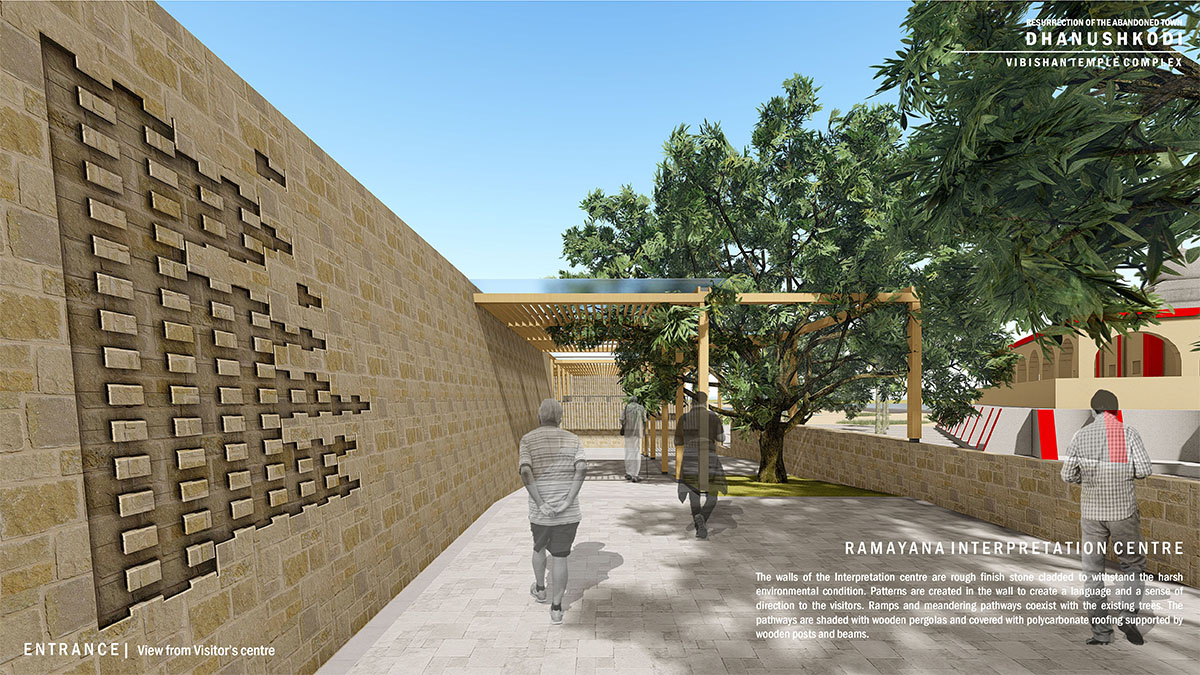
The walls of the Interpretation centre are rough finish stone to withstand the harsh environmental condition. Patterns are created in the wall to create a language and a sense of direction to the visitors. Ramps and meandering pathways coexist with the existing trees, The pathways are shaded with wooden pergolas and covered with polycarbonate roofing supported by wooden posts and beams.

Climbing down the entrance ramp the visitors reach the central courtyard surrounded by different function-specific buildings connected with a choreographed pathway come with covered with pergolas. The water channel runs bisecting the interpretation centre opening an uninterrupted view towards the temple's tomb. Rainwater Gargoyle runs inside the stone wall clad and opens into the water channel.
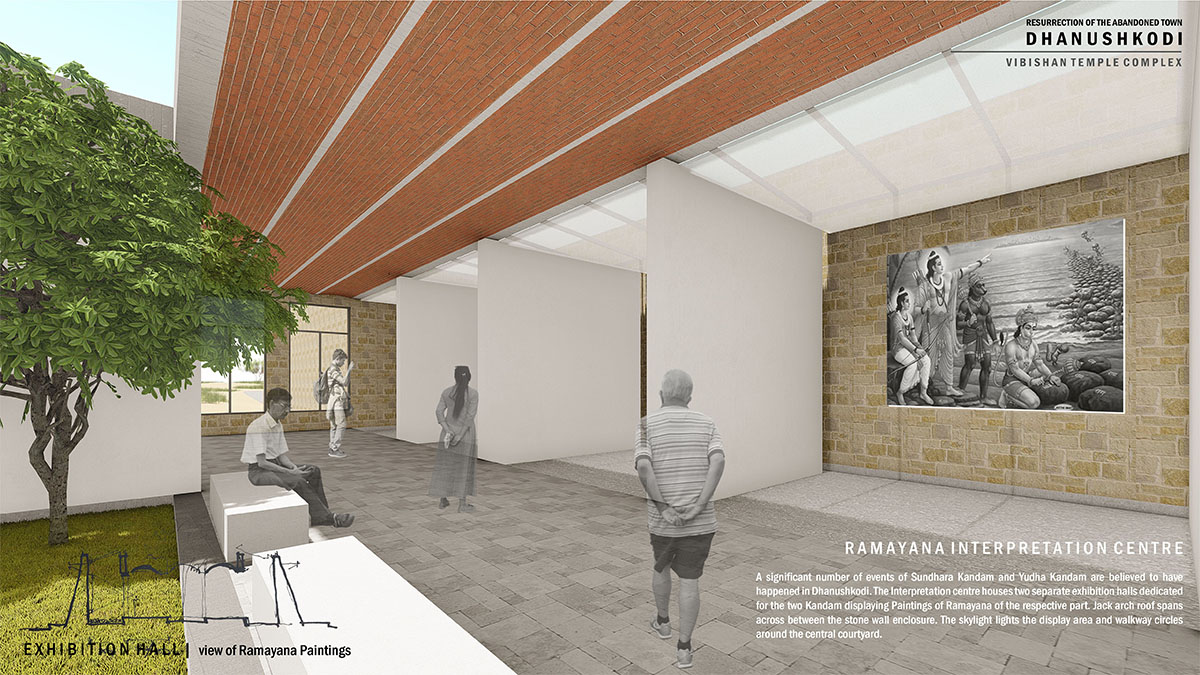
A significant number of events of Sundhara Kandam and Yudha Kandam are believed to have happened in Dhanushkodi. The Interpretation centre houses two separate exhibition halls dedicated for the two Kandam displaying Paintings of Ramayana of the respective part, Jack arch roof spans across between the stone wall enclosure. The skylight lights the display area and walkway circles around the central courtyard.
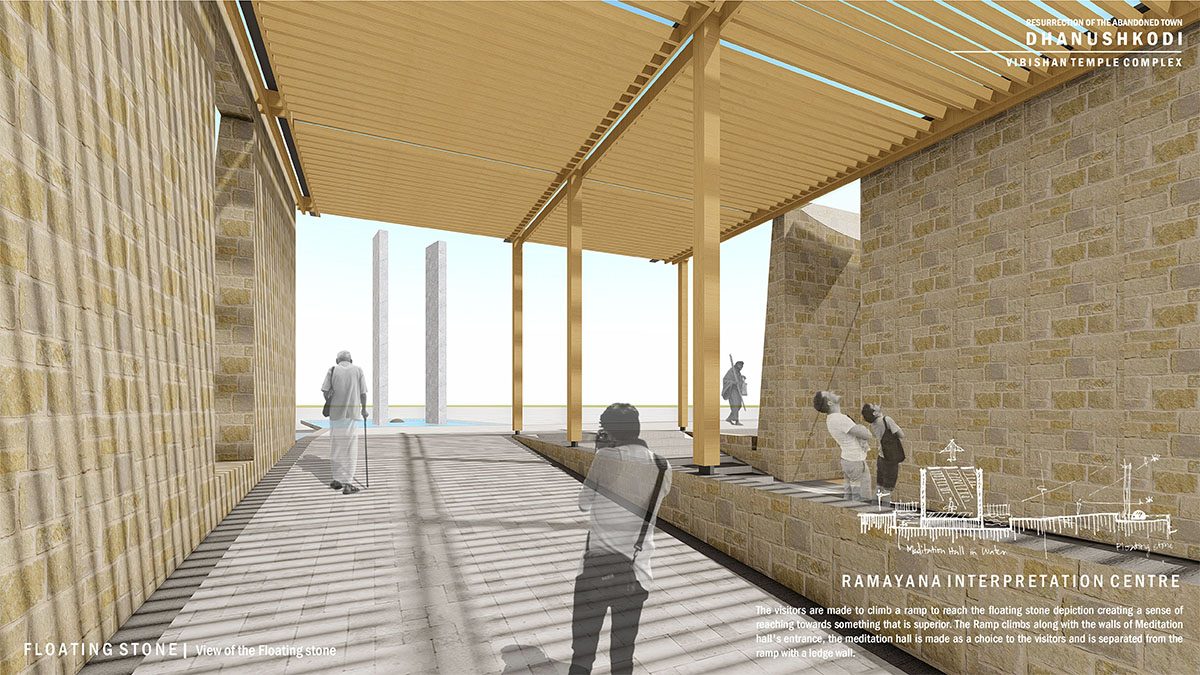
Visitors are made to climb a ramp to reach the floating stone depiction creating a sense of reaching towards something that is superior. The Ramp climbs along with the walls of Meditation hall's entrance, the meditation hall is made as a choice to the visitors and is separated from the famp with a ledge wall.

Dhanushkodi meaning "end of the arrow pallis nematter the art from Lord Rams bow.Drced In this land. Lord Rama sought help from the Lord Vunina (God of oceans and sky to cross the ocean to rescue his wife Seetha by meditating on the shares of Dhanushkodi The Meditation hall resonates this event, the water channel runs cutting the meditation hall. the Visitors can meditate by sitting on the beach sand under the spaceframe covered with fabric.
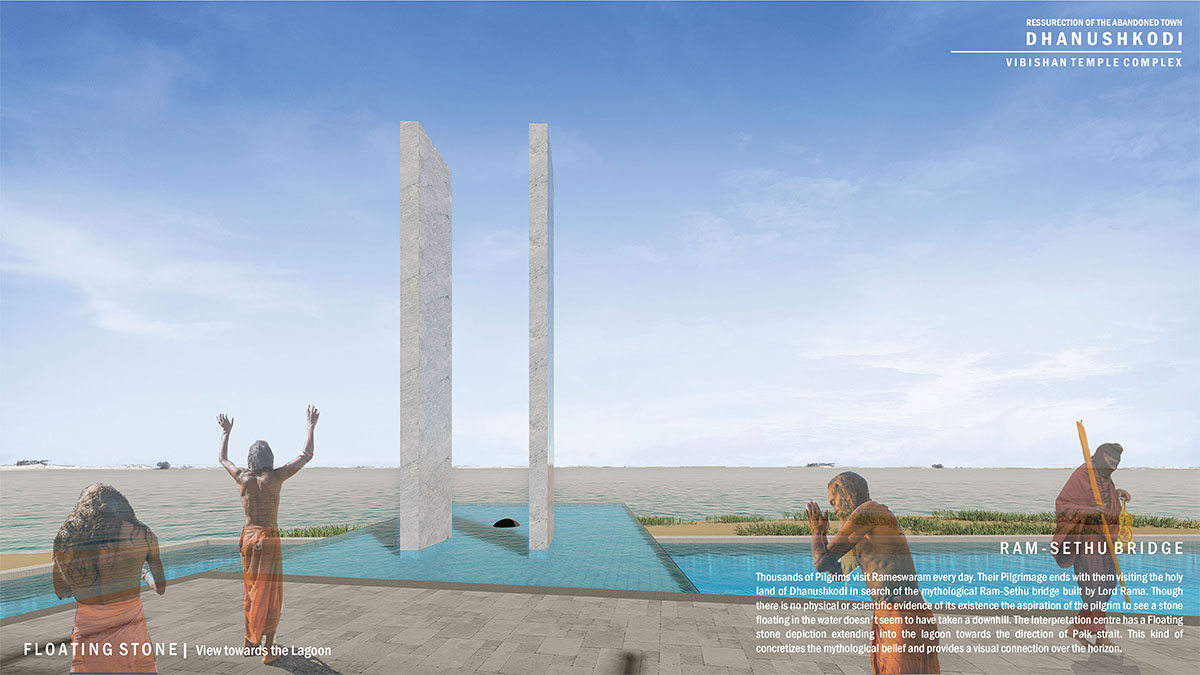
Thousands of Pilgrims visit Rameswaram every day. Their Pilgrimage ends with them visiting the holy land of Dhanushkodi in search of the mythological Ram-Sethu bridge built by Lord Rama. Though there is no physical or scientific evidence of its existence the aspiration of tie pilgrim to see a stone floating in the water doesn't seem to have taken a downhill. The Interpretation centre has a Floating stone depiction extending Into the lagoon towards the direction ot Palk stralt. This kind of concretizes the mythological bellef and provides a visual connection over the horizon.

The water channel from the Floating stone runs bisecting the Interpretation centre directing the vision towards the temple's tomb. The water channel runs cutting the meditation hall and reaches the central courtyard.
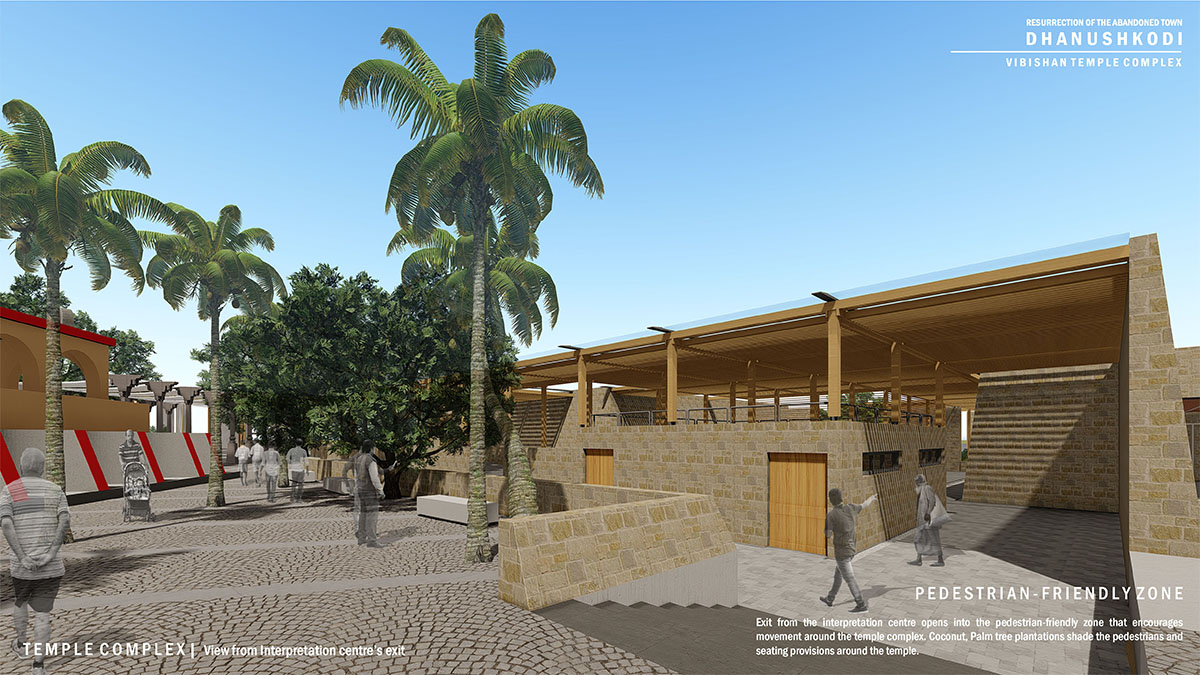
Exit from the Interpretation centre opens Into the pedestrian-friendly zone that encourages movement around the temple complex. Coconut, Palm tree plantations shade the pedestrians and seating provisions around the temple.

The Vibishan temple entrance is rethought by removing the sheet roofing pathway and replaced with carved stone pillars with fabric shading which accentuates the view towards the temple entrance without blocking the magnificent view of the temple. The pathway opens back to the visitor's centre completing the pilgrimage around the temple.

